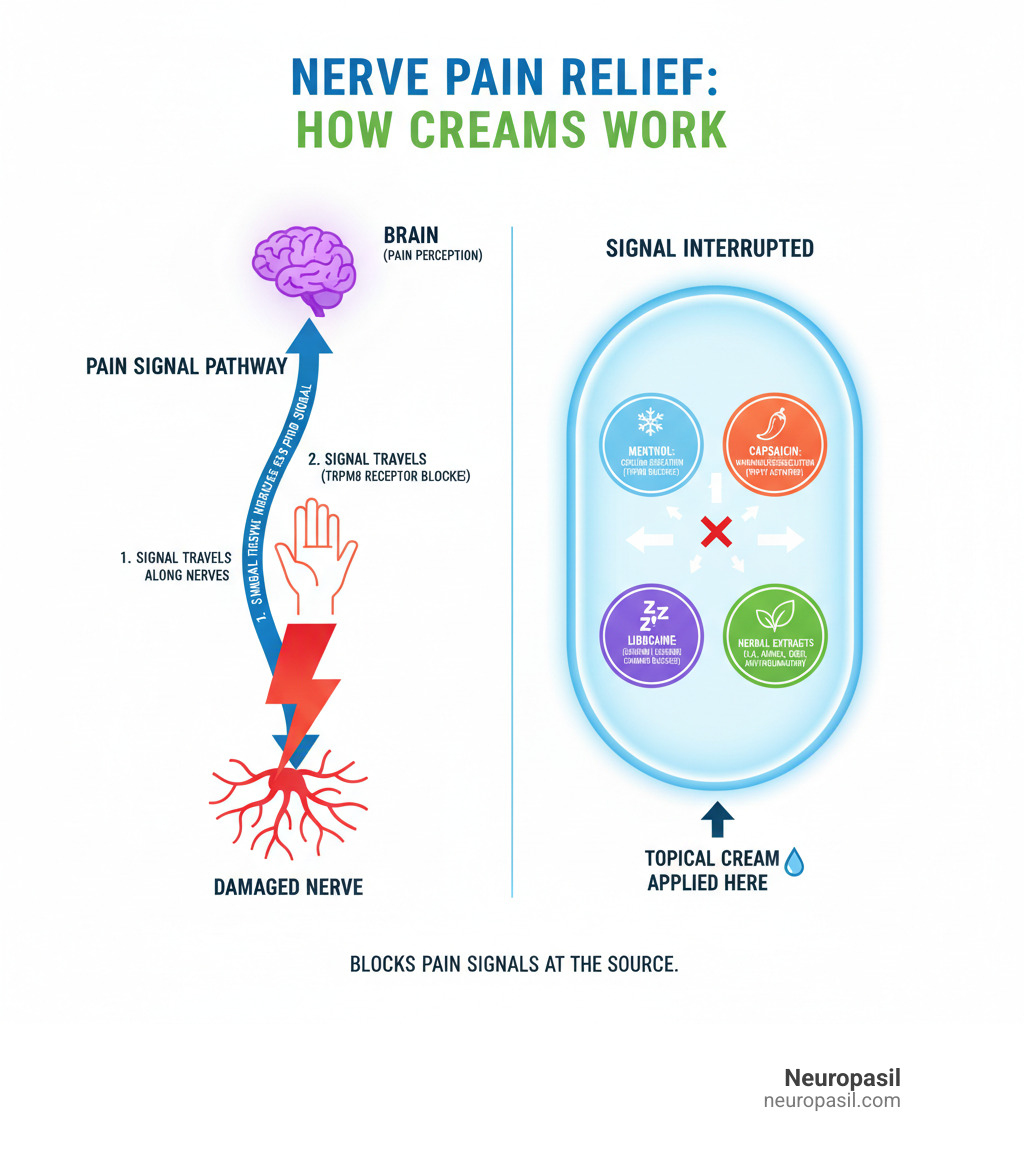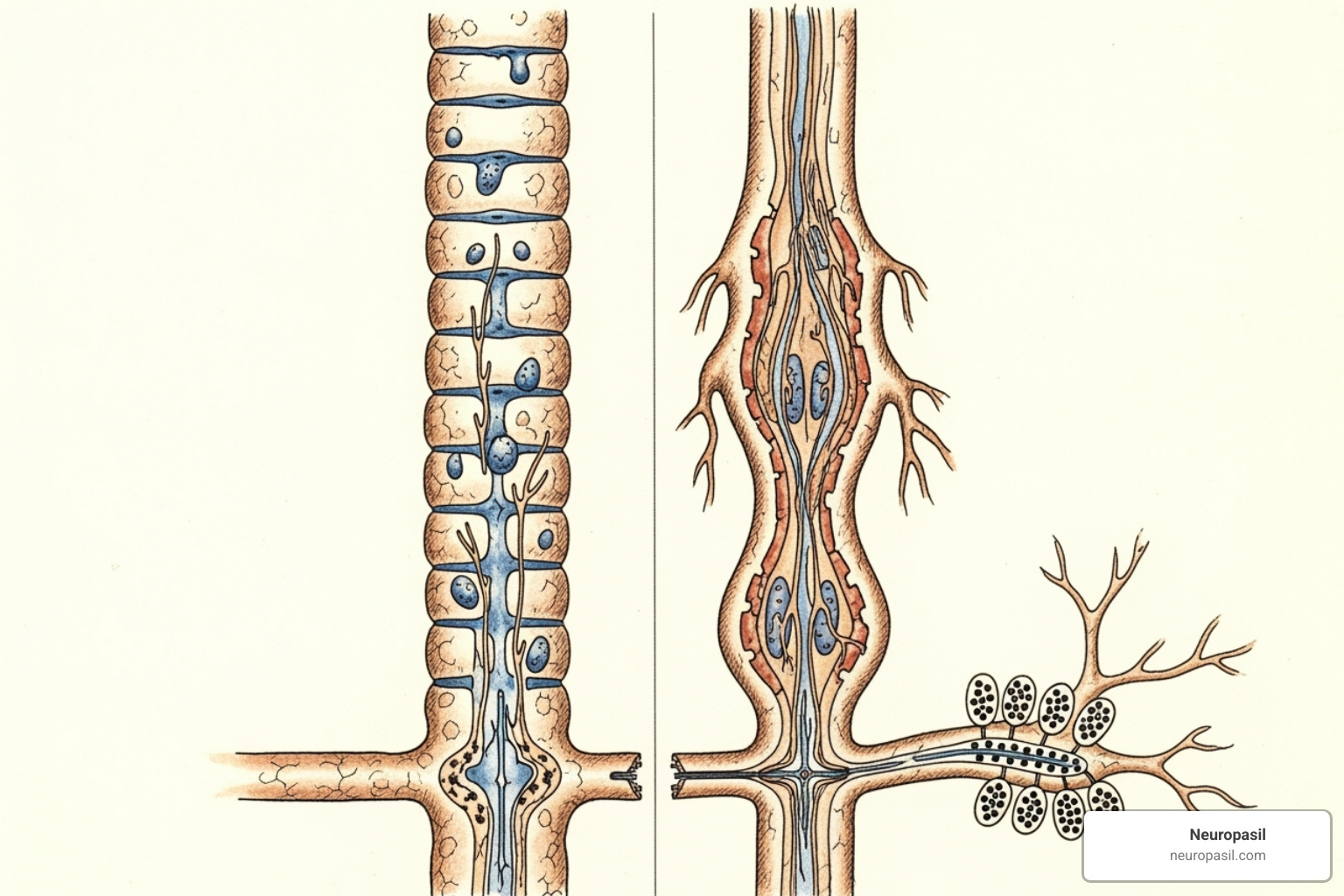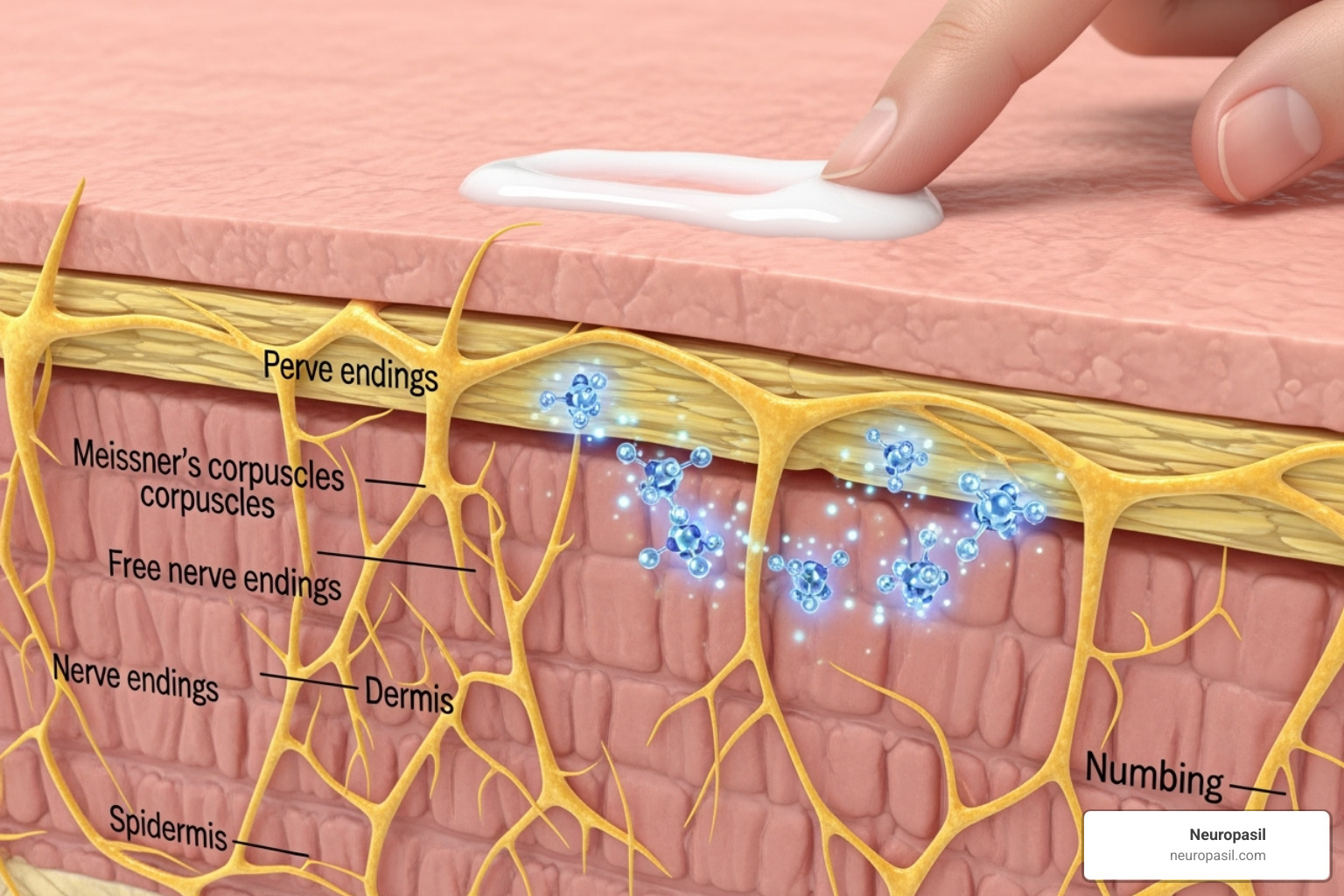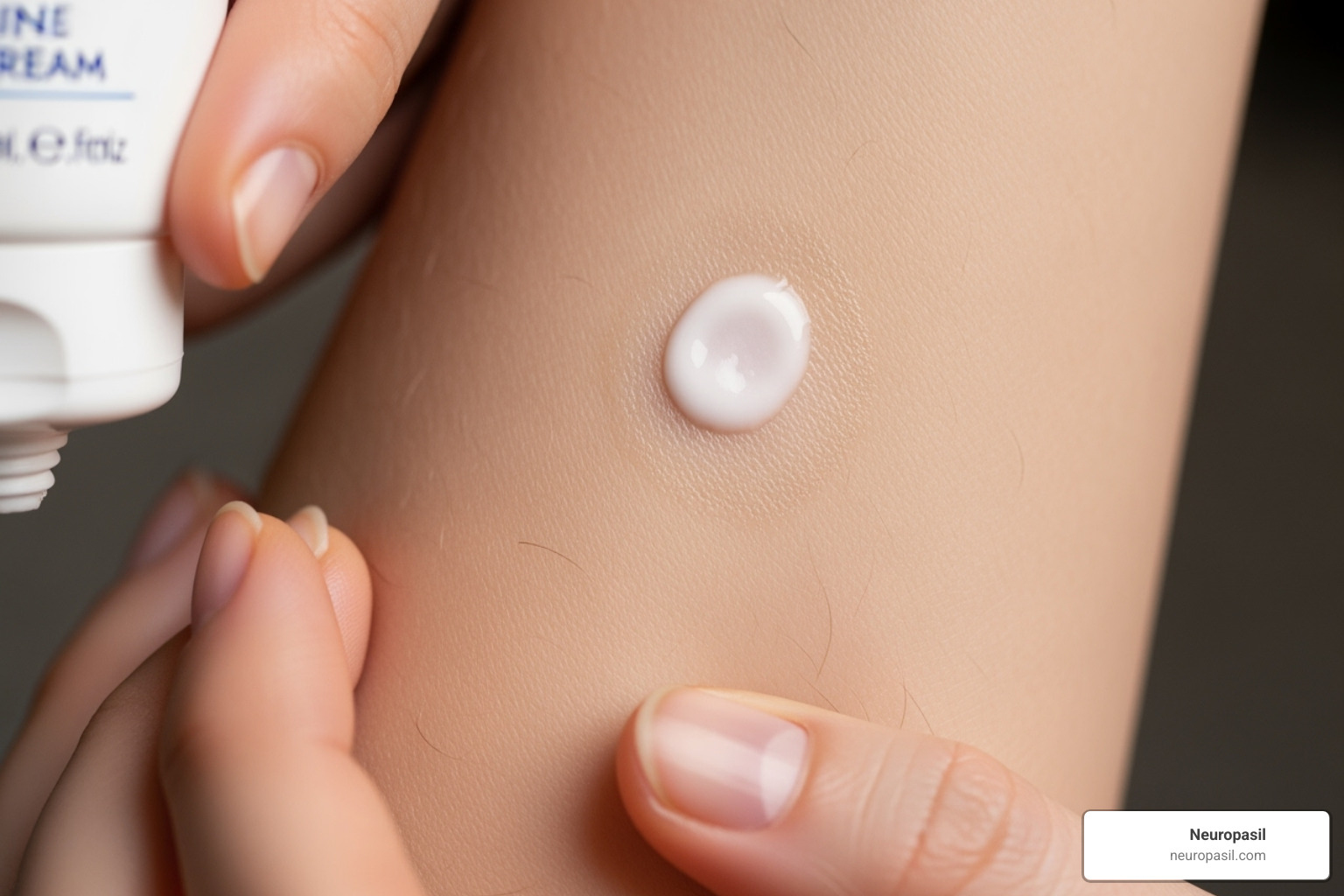Finding Relief from Nerve Pain
Nerve pain numbing cream offers targeted relief for millions dealing with neuropathy's challenging symptoms. These topical treatments work directly at the skin level to interrupt pain signals before they reach your brain.
Quick Facts About Nerve Pain Numbing Creams:
- Active ingredients: Menthol (cooling), capsaicin (warming), lidocaine (numbing), herbal extracts
- How they work: Block nerve signals, create counter-irritation, reduce inflammation
- Best for: Localized nerve pain in hands, feet, legs, and arms
- Relief time: Most start working within 5-60 minutes
- Application: Thin layer, 3-4 times daily maximum
- Safety: Patch test first, avoid broken skin, wash hands after use
Neuropathy affects an estimated 3-17% of the population, causing symptoms like burning, tingling, numbness, and shooting pain. The condition occurs when nerves become damaged from causes like diabetes, chemotherapy, injuries, or viral infections like shingles.
Unlike oral medications with body-wide side effects, topical creams deliver relief directly where you need it most.
Whether it's diabetic neuropathy in your feet or chemotherapy-induced pain in your hands, the right numbing cream can provide localized relief. The key is choosing the right formula by understanding how different ingredients work.

Understanding Neuropathy: The "Why" Behind the Pain
Your body's nervous system is a sophisticated communication network. When these nerves get damaged, the messages become static.

Neuropathy is the medical term for this damage. The static can feel like burning, tingling, sharp pains, or numbness. It might feel like you're wearing thick gloves or walking on hot coals.
Your nervous system has two parts: the central nervous system (brain and spinal cord) and the peripheral nervous system (nerves branching out to your limbs). Nerve pain numbing cream focuses on peripheral neuropathy, which affects these outer nerves.
You're not alone. Research shows 3–17% of the population experiences neuropathy.
What causes this nerve damage? Diabetes is a top cause, as high blood sugar damages nerves over time. Chemotherapy is another major culprit. Physical injuries and the shingles virus can also lead to chronic nerve pain. Other causes include autoimmune conditions, infections, and some medications.
While treating the underlying cause is important, topical treatments like nerve pain numbing cream can provide much-needed relief right where you hurt most. To learn more about what to watch for, check out our guide on Peripheral Neuropathy Symptoms.
How Nerve Pain Numbing Cream Works: The Science of Relief
Think of nerve pain numbing cream as a pain interceptor. Unlike oral medications that travel through your body, topical treatments work directly where you apply them. They deliver ingredients through your skin to the nerves underneath, blocking or disrupting pain signals before they reach your brain. This targeted approach provides relief right where you hurt, without systemic side effects.
Many creams now use natural, plant-based ingredients. These botanicals offer gentle, effective ways to calm irritated nerves and reduce inflammation.

Let's explore how the main players in these creams work their magic on your nerves.
The Cooling Sensation of Menthol
The refreshing tingle from a mentholated cream is more than just a sensation; it's menthol distracting your brain from the pain.
Menthol is a counter-irritant. It activates cold receptors (TRPM8 receptors) on your skin, sending "cold" signals to your brain. Your brain gets busy processing the cooling sensation, which overrides the pain signals, similar to how rubbing a bumped elbow provides relief.
The cooling effect is therapeutic. Research shows that a 1% menthol cream can significantly reduce nerve pain. The American Society of Clinical Oncology recognizes topical menthol as a promising treatment for chemotherapy-induced nerve pain. You can read more about this research on topical menthol for chemotherapy-induced neuropathy.
While menthol is generally safe, products with more than 3% concentration need careful handling. Always follow the directions on your cream to avoid skin irritation.
The Soothing Power of Herbal Extracts
Today's nerve pain numbing creams often blend traditional herbal wisdom with modern science for gentle, effective formulas.
Arnica is a traditional remedy for reducing inflammation and swelling, which can worsen nerve pain. Its inclusion in creams is backed by an understanding of how inflammation affects nerve discomfort.
St. John's Wort contains compounds that may help calm nerve-related discomfort. The oil from Hypericum perforatum works to soothe irritated nerves naturally.
CBD oil is a newer star in natural pain management. A small 2020 study showed that topical CBD significantly reduced sharp pain, cold sensations, and itching after four weeks, with no adverse effects reported.
Essential oils add more natural healing power. Peppermint, frankincense, tea tree, and wintergreen oils each bring their own pain-fighting properties to calm inflammation and support nerve comfort.
For a deeper dive into how plants can help heal nerve pain, check out this comprehensive review of medicinal herbs for neuropathic pain.
The Depleting Effect of Capsaicin
Capsaicin, the fiery compound in chili peppers, helps cool down nerve pain. It sounds counterintuitive, but there's solid science behind it.
When you first apply a capsaicin ointment, you'll likely feel warmth or burning. That's capsaicin targeting a pain chemical in your nerves called Substance P.
With regular use, capsaicin gradually depletes Substance P from your nerve endings. With less Substance P, your nerves can't send as many pain signals to your brain. This process desensitizes your nerves over time, quieting the pain.
The research backing capsaicin is solid. Studies show high-concentration patches can provide relief for postherpetic neuralgia (shingles pain). A 2017 review found that while not everyone responds, those who do often see significant improvement. You can explore the evidence on high-concentration capsaicin for chronic neuropathic pain.
The key with capsaicin is patience and consistency. The initial discomfort gives way to relief as your nerves adapt. Just remember to keep it away from your eyes and any broken skin.
Choosing Your Cream: A Guide to Active Ingredients
Finding the right nerve pain numbing cream doesn't have to feel overwhelming. Think of it like choosing the perfect recipe – you want ingredients that work well together and match your specific needs. The good news is that many effective creams focus on natural and plant-based ingredients that have been trusted for generations.

When you're browsing the shelves or shopping online, you'll notice that most creams fall into a few main categories. Menthol-based rubs are incredibly popular because they work fast – often providing that cooling relief in just minutes. These creams create an immediate distraction from your nerve pain while your brain focuses on the cooling sensation instead.
Capsaicin ointments take a different approach entirely. Yes, they're made from chili peppers, and yes, they might feel warm or even burn a little at first. But here's the fascinating part: with regular use, they actually train your nerves to become less sensitive to pain signals. It's like gradually turning down the volume on your pain receptors.
Common Natural Formulations
The beauty of modern nerve pain numbing cream formulations is how they blend traditional wisdom with scientific understanding. Many creams combine several natural ingredients to tackle nerve pain from multiple angles.
Herbal blends are becoming increasingly sophisticated. Take comprehensive formulations that include menthol for immediate cooling, arnica for inflammation, and St. John's Wort for nerve support – all in one jar. These multi-ingredient approaches recognize that nerve pain is complex and often responds best to a variety of soothing compounds working together.
Combination products might pair a cooling agent like menthol with warming ingredients like capsaicin, giving you both immediate relief and longer-term desensitization benefits. It's like having a toolkit rather than just one tool.
Natural & Herbal Ingredients in a Nerve Pain Numbing Cream
The world of natural pain relief is rich with options that have stood the test of time. Arnica has been used for centuries to calm inflammation and reduce swelling – both of which can make nerve pain worse. When your nerves are already irritated, reducing that extra inflammation can make a real difference in your comfort level.
St. John's Wort might surprise you. While most people know it for mood support, this herb also contains compounds that can help soothe nerve discomfort. It's often included in oil form in premium formulations for its gentle yet effective nerve-supporting properties.
CBD oil represents the newer frontier of natural pain relief. Research shows it can significantly reduce sharp, intense nerve pain as well as those annoying cold and itchy sensations that come with neuropathy. The best part? Studies haven't found troublesome side effects when used topically.
Essential oils add both therapeutic benefits and a pleasant sensory experience. Peppermint oil amplifies the cooling effect, while frankincense and tea tree oil bring anti-inflammatory properties to the mix. Wintergreen and black pepper oils can create gentle warmth and improve circulation, while lemongrass and sweet marjoram offer calming, soothing effects that help your whole body relax.
The magic happens when these ingredients work together synergistically. Instead of just masking pain, they address inflammation, support nerve health, and create multiple pathways to relief. For deeper insights into how these botanical remedies can help with nerve pain, this review of medicinal herbs for neuropathic pain offers valuable scientific perspective.
The best cream for you depends on your specific type of nerve pain, skin sensitivity, and personal preferences. Some people love the immediate cooling sensation of menthol, while others prefer the gradual, long-term benefits of capsaicin or the gentle approach of herbal blends.
Topical vs. Oral Approaches: What's Right for You?
When you're dealing with nerve pain, you're faced with an important choice: should you reach for a nerve pain numbing cream or ask your doctor about oral medication? It's a bit like choosing between a precision tool and a sledgehammer – both can be effective, but they work in completely different ways.
The main difference comes down to localized versus systemic treatment. Think of topical creams as your targeted approach – they work right where you apply them, like having a conversation with your nerves at skin level. Oral medications, on the other hand, travel through your bloodstream to reach nerves throughout your entire body.
This fundamental difference affects everything from how quickly you feel relief to what side effects you might experience. Nerve pain numbing creams often start working within 5 to 60 minutes, giving you that "ahh" moment of localized relief. Oral medications like gabapentinoids or certain antidepressants can take days or even weeks to build up in your system before you notice significant improvement.
| Feature | Nerve Pain Numbing Creams | Oral Medications (e.g., Gabapentinoids, Antidepressants) |
|---|---|---|
| Action | Localized, targets pain at the skin level | Systemic, affects the entire body |
| Onset Time | Often fast (5-60 minutes for local effect) | Can take days to weeks to build up in the system |
| Side Effects | Generally localized (skin irritation, dryness, burns) | Systemic (drowsiness, dizziness, nausea, weight gain) |
| Use Cases | Localized pain, mild-to-moderate neuropathy, adjunct therapy | Widespread pain, severe/chronic neuropathy, underlying systemic issues |
| Prescription Req. | Many OTC, some high-strength are prescription-only | Most are prescription-only |
The side effect profiles tell an interesting story too. With creams, you might experience some skin irritation, dryness, or in rare cases with high-concentration products, burns. But these effects stay local. Oral medications can bring along unwanted guests like drowsiness, dizziness, nausea, and weight gain – effects that can impact your entire day.
When Creams Are a Better Choice
There are certain situations where nerve pain numbing cream really shines as your best option. If your pain has a specific address – like tingling feet from diabetic neuropathy or the shooting pain of Sciatica Pain down your leg – topical treatment can deliver relief right to that zip code.
Avoiding systemic side effects is another compelling reason to choose creams. Maybe you've tried oral medications before and felt like you were walking through fog all day, or perhaps you're already taking several medications and don't want to add another pill to the mix. Studies have shown that topical lidocaine can be particularly beneficial for people with peripheral neuropathic pain who simply can't tolerate oral medications or have experienced unpleasant reactions.
Don't overlook the power of adjunct therapy either. Even if you're successfully managing your nerve pain with oral medication, a cream can serve as your backup dancer – providing extra relief for breakthrough pain or targeting those stubborn "hot spots" that your pills might not fully address.
Of course, creams have their limitations. If your nerve pain is widespread or severe, you'll likely need the stronger, whole-body approach that prescription oral medications provide. It's not about one being better than the other – it's about finding what works best for your unique situation.
How to Choose the Best Nerve Pain Numbing Cream
Choosing the right nerve pain numbing cream doesn't have to feel overwhelming. Think of it as matching the right tool to your specific job.
Ingredient concentration matters more than you might think. A cream with 4-5% lidocaine will pack more punch than one with just 1%, but higher-strength options often require a prescription. The same goes for capsaicin and menthol – check those percentages on the label.
Your target pain type should guide your ingredient choices. If you love that cooling, "minty fresh" sensation that distracts from pain, menthol-based creams are your friend. For chronic pain that needs desensitizing over time, capsaicin might be worth the initial burning sensation. Want direct skin numbing? Lidocaine is your go-to. Prefer a gentler, more holistic approach? Look for creams with herbal blends like arnica, St. John's Wort, or CBD.
Skin sensitivity is nothing to ignore. Some people can handle capsaicin like a champ, while others find even mild menthol irritating. Always do a patch test first – it's like a first date for your skin and the cream. Look for formulas described as non-greasy and enriched with soothing ingredients like aloe vera and vitamin E.
Here's the most important part: doctor consultation. This isn't just covering our bases – it's genuinely crucial. If your nerve pain is chronic, severe, getting worse, or you're not sure what's causing it, your doctor needs to be in the loop. They can provide a proper diagnosis and recommend the most suitable treatment, especially considering any other medications you're taking.
Finally, consider brand reputation and real user reviews. Companies with decades of experience in nerve care often indicate a commitment to quality and ongoing research. Look for reviews that specifically mention effectiveness for nerve pain, not just general muscle soreness.
The right cream can make a real difference in your daily comfort – it's worth taking the time to choose wisely.
Safe Usage and Important Precautions
Using nerve pain numbing cream safely is like following a trusted recipe – skip the important steps, and you might not get the results you're hoping for. The good news is that these creams are generally safe when used properly, but a few simple precautions can make all the difference between effective relief and unwanted complications.
Think of it this way: your skin is your body's protective barrier, and when you apply a topical treatment, you're asking it to let those healing ingredients through. Being mindful about how you do this ensures you get maximum benefits while keeping risks to a minimum.

Best Practices for Application
Getting the most from your nerve pain numbing cream starts with smart application habits. Always patch test first – this simple step could save you from an uncomfortable reaction later. Apply a small dab to an inconspicuous area like your inner forearm and wait 24 hours. If you notice any redness, itching, or irritation, that cream isn't right for you.
When you're ready to apply the cream, make sure you're working with clean, intact skin. Never apply these products to cuts, scrapes, or open wounds, as this can lead to too much absorption into your bloodstream or cause painful irritation. Think of broken skin as having the door wide open – you want more control over how much gets in.
Here's something many people forget: wash your hands thoroughly after each application. Unless you're treating your hands specifically, you don't want to accidentally transfer the cream to your eyes, mouth, or other sensitive areas later. It's a simple step that prevents a lot of potential problems.
Be gentle with the treated area afterward. Avoid tight bandaging – if you need to cover the area, keep it loose. The cream needs to work at the skin level, not be pushed deeper by pressure. Similarly, skip the heating pads or ice packs on treated skin. The FDA has actually warned about rare cases of serious burns when people combine topical pain relievers with heat sources.
Stick to the recommended dosage and timing on your product label. Most creams suggest applying a thin layer every 6 to 8 hours, with no more than 3 applications daily. More isn't better when it comes to topical medications – it just increases your risk of side effects.
When to See a Doctor
While nerve pain numbing cream can provide wonderful relief, it's not meant to replace professional medical care, especially for ongoing issues. Your body has ways of telling you when it's time to seek help, and it's important to listen.
If your pain gets worse or doesn't improve after several days of consistent use, something else might be going on. Sometimes nerve pain is a symptom of a larger issue that needs medical attention. The same goes if your symptoms seem to clear up but then return quickly – this pattern often signals an underlying condition that needs proper diagnosis.
Watch for signs that your nerve pain might be part of a bigger picture. If you're experiencing widespread numbness, unexplained weakness throughout your body, or other concerning symptoms beyond localized pain, these could indicate systemic issues that require immediate medical evaluation.
Before starting any new treatment for chronic pain, even an over-the-counter cream, it's wise to check with a healthcare professional. They can help identify what's causing your nerve pain and create a comprehensive treatment plan. This is especially important if you're dealing with conditions like diabetes, have a history of chemotherapy, or suspect your pain stems from an injury.
Stop using the cream immediately and contact a doctor if you develop severe skin reactions – excessive redness, intense burning, swelling, or blistering in the treated area. These aren't normal responses and need professional attention.
Special populations need extra caution too. Always consult a doctor before using these products on children 12 and under, and if you're pregnant or nursing, get medical guidance first. If you're taking other medications, particularly blood thinners or oral pain relievers, ask your doctor or pharmacist about potential interactions.
Seeking medical advice isn't admitting defeat – it's taking smart steps to ensure your nerve pain gets the comprehensive care it deserves. Your healthcare provider can work with you to find the most effective and safe approach for your specific situation.
Conclusion: Take Control of Your Nerve Pain
Living with nerve pain doesn't have to mean accepting constant discomfort as your new normal. Throughout this guide, we've finded how nerve pain numbing cream can be a game-changer for targeted relief, working right where you need it most to interrupt those stubborn pain signals before they reach your brain.
Think of it this way: you now have a toolkit of knowledge. You understand how menthol creates that cooling distraction, how capsaicin gradually desensitizes overactive nerves, and how natural herbal extracts like arnica and St. John's Wort can soothe inflammation and support nerve comfort. Each ingredient brings its own strengths to the table, whether you need immediate cooling relief or long-term nerve desensitization.
The beauty of topical treatments lies in their precision. Unlike oral medications that affect your entire system, these creams deliver relief exactly where you're hurting. Whether you're dealing with diabetic neuropathy in your feet, chemotherapy-induced nerve pain in your hands, or localized discomfort from an old injury, you can now make informed choices about which approach might work best for your unique situation.
Knowledge is your greatest ally in this journey. You've learned when topical creams shine over oral medications – especially for localized pain and when you want to avoid systemic side effects. You've finded the importance of patch testing, proper application techniques, and when it's time to consult with your doctor. These aren't just safety tips; they're your roadmap to effective, safe relief.
Your path to comfort doesn't have to be traveled alone. A holistic approach that combines the right topical treatments with professional medical guidance can make all the difference. Sometimes the most effective strategy involves multiple approaches working together – and that's perfectly okay.
At Neuropasil, we believe in empowering you with natural solutions that support your journey toward better nerve health. Taking control of your nerve pain starts with understanding your options, and you've taken that important first step today.
Ready to explore more natural approaches to nerve comfort? Explore natural solutions for nerve pain relief with Neuropasil and find how targeted, natural care can become part of your wellness routine.














